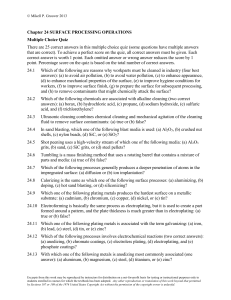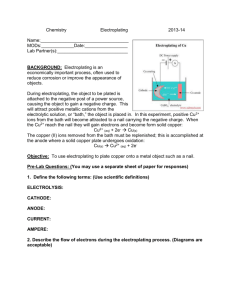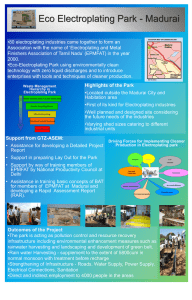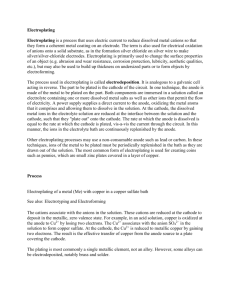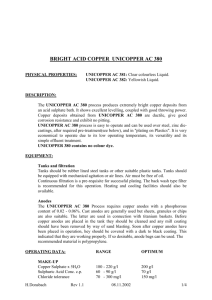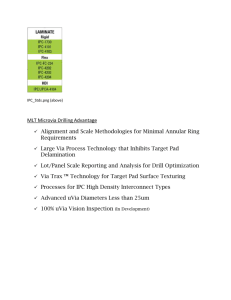Damascene copper electroplating for chip interconnections
advertisement
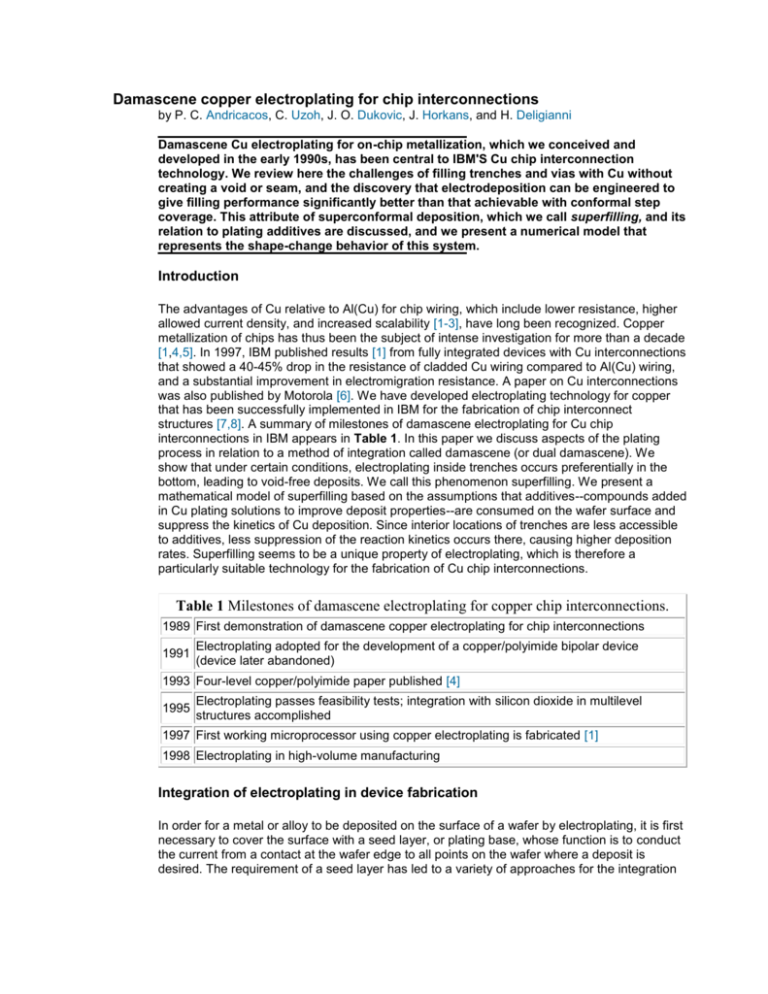
Damascene copper electroplating for chip interconnections by P. C. Andricacos, C. Uzoh, J. O. Dukovic, J. Horkans, and H. Deligianni Damascene Cu electroplating for on-chip metallization, which we conceived and developed in the early 1990s, has been central to IBM'S Cu chip interconnection technology. We review here the challenges of filling trenches and vias with Cu without creating a void or seam, and the discovery that electrodeposition can be engineered to give filling performance significantly better than that achievable with conformal step coverage. This attribute of superconformal deposition, which we call superfilling, and its relation to plating additives are discussed, and we present a numerical model that represents the shape-change behavior of this system. Introduction The advantages of Cu relative to Al(Cu) for chip wiring, which include lower resistance, higher allowed current density, and increased scalability [1-3], have long been recognized. Copper metallization of chips has thus been the subject of intense investigation for more than a decade [1,4,5]. In 1997, IBM published results [1] from fully integrated devices with Cu interconnections that showed a 40-45% drop in the resistance of cladded Cu wiring compared to Al(Cu) wiring, and a substantial improvement in electromigration resistance. A paper on Cu interconnections was also published by Motorola [6]. We have developed electroplating technology for copper that has been successfully implemented in IBM for the fabrication of chip interconnect structures [7,8]. A summary of milestones of damascene electroplating for Cu chip interconnections in IBM appears in Table 1. In this paper we discuss aspects of the plating process in relation to a method of integration called damascene (or dual damascene). We show that under certain conditions, electroplating inside trenches occurs preferentially in the bottom, leading to void-free deposits. We call this phenomenon superfilling. We present a mathematical model of superfilling based on the assumptions that additives--compounds added in Cu plating solutions to improve deposit properties--are consumed on the wafer surface and suppress the kinetics of Cu deposition. Since interior locations of trenches are less accessible to additives, less suppression of the reaction kinetics occurs there, causing higher deposition rates. Superfilling seems to be a unique property of electroplating, which is therefore a particularly suitable technology for the fabrication of Cu chip interconnections. Table 1 Milestones of damascene electroplating for copper chip interconnections. 1989 First demonstration of damascene copper electroplating for chip interconnections 1991 Electroplating adopted for the development of a copper/polyimide bipolar device (device later abandoned) 1993 Four-level copper/polyimide paper published [4] 1995 Electroplating passes feasibility tests; integration with silicon dioxide in multilevel structures accomplished 1997 First working microprocessor using copper electroplating is fabricated [1] 1998 Electroplating in high-volume manufacturing Integration of electroplating in device fabrication In order for a metal or alloy to be deposited on the surface of a wafer by electroplating, it is first necessary to cover the surface with a seed layer, or plating base, whose function is to conduct the current from a contact at the wafer edge to all points on the wafer where a deposit is desired. The requirement of a seed layer has led to a variety of approaches for the integration of plating; two such approaches are illustrated in Figure 1. Figure 1 Through-mask plating uses a masking material on top of the seed layer. Electroplating occurs only on those areas of the seed layer that are not covered by the mask. The masking material and the surrounding seed layer are subsequently removed. Through-mask plating has been implemented in the fabrication of thin-film recording heads [9,10] and C4 interconnections [11]. Damascene plating, in contrast, involves deposition of the seed layer over a patterned material, which, in the case of interconnect structures, is the insulator, a functional part of the device that must remain in place. The plated metal covers the entire surface; excess metal must be removed by a planarization step such as chemical-mechanical polishing (CMP). Damascene electroplating is ideally suited for the fabrication of interconnect structures, since it allows inlaying of metal simultaneously in via holes and overlying line trenches [12] by a process called dual damascene (Figure 2). Further, it is compatible with the requirement for a barrier layer between the seed layer and the insulator; the barrier prevents interaction between the metal and the insulator [13]. Figure 2. The foremost requirement for success of the plating process (as well as for any other process of potential use in the fabrication of damascene copper interconnects) is its ability to fill trenches, vias, and their combinations completely, without any voids or seams. How plating makes it possible to obtain void-free and seamless deposits is discussed in the next section. Profile evolution in damascene copper plating Figure 3 shows possible ways for the profile of plated copper to evolve in time. In conformal plating, a deposit of equal thickness at all points of a feature leads to the creation of a seam, or, if the shape of the feature is reentrant, a void. Subconformal plating leads to the formation of a void even in straight-walled features. Subconformal plating results when substantial depletion of the cupric ion in the plating solution inside the feature leads to significant concentration overpotentials which, in turn, cause the current to flow preferentially to more accessible locations outside the feature. Also, if the feature depth is large (say in excess of 50 µm), the ohmic drop in the electrolyte may cause nonuniformity in the distribution of the current in favor of external feature locations. For defect-free filling, a higher deposition rate in the bottom than on the sides of the feature is desired. This mode of plating, as shown in Figure 3, can be accomplished by the use of additives. The term superfilling is used here to distinguish the situation from leveling. Leveling reduces the roughness of a surface and smooths defects such as scratches; superfilling produces void-free and seamless deposits inside lithographically defined cavities with vertical walls and high aspect ratios. Figure 3. The results of experiments conducted using different additives are shown in Figure 4. The specific additives used are proprietary. Plating was interrupted before the feature was completely filled with Cu in order to assess the shape of the profile of the deposited metal. Superfilling results in one case (a); in the other (b), a nearly conformal deposit is obtained. Superfilling also involves rounding of the corners of the trench bottom. Rounding is observed in both cases. Figure 4 A model of superfilling With the aim of improving our understanding of shape-change behavior in damascene plating through a quantitative framework, we undertook a numerical modeling effort in 1991. We adapted a model that had been applied to leveling in conventional electroplating [14] and to shape evolution in through-mask plating [15]. Physically, the essential characteristics of the model are as follows. The local rate of copper deposition is proportional to the local current density i by Faraday's law. The current distributes itself so as to take the path of least resistance as it approaches the trenched electrode surface. Transport of the metal ion M (in this case, the cupric ion, Cu2+) and of an inhibiting additive A is dominated by convection except within a concentration boundary layer that extends several tens of microns from the electrode surface. We treat this zone as stagnant, with each species moving only by diffusion. At the outer edge of the boundary layer, we assume that the cupric ion and the inhibitor are at their well-mixed bulk concentrations. Since the feature dimensions are much smaller than the boundary-layer thickness, we take i to be uniform at the boundarylayer edge. The current encounters a voltage barrier or overpotential at the electrode surface. Since the barrier becomes higher as current density increases (according to the Tafel kinetic expression [16]), there is no reason for a point A to receive a higher current density than a point B unless one of the following cases applies: 1. The ohmic pathway to point A is significantly more favorable than to point B. 2. The metal ion has been depleted to a significantly lower concentration at point B than at point A (difference in concentration overpotential). 3. The rate constant for electrodeposition, i0, is higher at point A than at point B as the result of differential inhibition or catalysis. We can rule out Case 1, since ohmic drop in the plating solution is negligible at the length scale of 1 µm. Case 2 applies only as the current density approaches the transport-limited current density iL, which is nearly always avoided. (It is noteworthy that neither effect 1 nor 2 could cause superconformal plating; rather, each would result in subconformal coverage.) We are left with Case 3. It is well known that i0 can be strongly influenced by adsorbed inhibitors. There would be no reason for the surface concentration of adsorbate to vary along the profile unless it were influenced by the diffusive transport of the inhibitor A. It must be recognized that diffusion cannot have a sustained effect unless the adsorbate is consumed (either by reaction or by incorporation into the deposit). The simplest and strongest case of diffusion influence is diffusion control; hence we assume, for simplicity, that the concentration of inhibitor cA drops to zero in the electrolyte at the electrode surface. Under this assumption, the flux of the inhibitor, NA, is easy to compute from a boundary-value problem corresponding to Fick's second law of diffusion. From the nature of the Laplace equation, we know that strong field effects driven by the profile geometry can arise, causing strong variations in NA along the profile. Taking the view that the surface concentration of the adsorbates responsible for retarding electrodeposition is determined by a dynamic balance between the arrival of fresh additive and its consumption, we relate the degree of kinetic inhibition directly to the flux of inhibitor NA. We do this simply by multiplying the rate constant for electrodeposition by an inhibition factor , which ranges between 1 and 0, decreasing monotonically with the dimensionless inhibitor flux N *A. The form of the expression (N*A) is discussed below. A simple area-blockage treatment of inhibition [17] has been employed in a shape-change simulation to model classical leveling with some success [18]. An equivalent description of inhibited kinetics was used in Reference [15], where the inhibition factor had the form = (1/(1 + KLEV(N*A/N*M)). However, we found that such a treatment was not adequate to describe the shape-change behavior that we refer to as superfilling. In particular, the area-blockage model can describe differences in local kinetics necessary to cause slower plating outside the cavity than inside, but it cannot generate the magnitude of rate differentiation within the cavity that permits the rounding of the internal corners and the prevention of seam formation. We found it necessary to use an inhibition expression (N*A) for which varies gradually over a very wide range of NA, i.e., several orders of magnitude. Some experimental support for this finding is furnished by the observation that, in a plating bath with all components at standard concentration except for one inhibiting additive, the plating potential jumps significantly when the inhibitor concentration is raised from 2% to 4% of its nominal value, and this sensitivity extends over roughly two orders of magnitude in concentration. The expression we adopted was = (1/1 + b N*Ap). The fractional exponent p was introduced, somewhat empirically, to widen the dynamic range of fluxes over which differential inhibition can occur. Values of p = 1/4 and b = 10 were chosen, mainly to capture the corner rounding and general shape-change behavior observed experimentally. The mathematical system is summarized in dimensionless form in Figure 5. All equations and nomenclature correspond directly to Reference [15], with three exceptions. First and most important, the present model uses a different expression for the inhibition factor , as noted above. A second difference, of minor consequence, is that in the present model, we neglect the anodic or reverse-reaction term of the Butler-Volmer kinetic expression [Reference [15], Equation (19)], leaving the simpler Tafel expression. A third difference is that the mean current density in the present model (which enters the dimensionless groups WaT and Sh) is based on the superficial area rather than the topographic area of the trenched electrode. Figure 5. An account of the problem statement of Figure 5 follows. Within a laterally symmetric section of the concentration boundary layer (shaded in pink), there are three field variables, which all obey the Laplace equation: the dimensionless potential *, the dimensionless metal-ion concentration c*M, and the dimensionless additive concentration c*A. The surface-normal derivatives * * • n*, and *c*M • n* (abbreviated in the figure as *', c*A', and c*M' are constrained to zero at the symmetry boundaries (i.e., there are no fluxes across symmetry lines). At the top of the boundary layer the potential gradient is taken to be uniform, *' = 1, and the metal ion and inhibitor are at their bulk concentrations, c*M = 1 and c*A = 1. It is only at the electrode surface that the three field variables, *, c*M, and c*A, are coupled. Here, we impose c*A = 0, in accordance with the assumption that the inhibitor is consumed under mass-transfer control. The resulting flux profile, N*A = c*A • n, enters the expression for in the kinetic expression *' = k c*M( + c/n)e */WaT, which relates the field variables * and c*M (where k is a dimensionless rate constant, kiO ,cA=0/ ). The potential and the metal-ion concentration are also related by a fluxmatching condition, c*'M = Sh *'. The solution depends on WaT, Sh, + c/n, b, and p. (The rate constant k does not affect the current distribution under Tafel kinetics.) The parameters Wa, Sh, and + /n are not freely adjustable, but are determined from handbook constants and process conditions. The numerical method (quadratic boundary element method) was the same as that of Reference [15], and the scheme for repositioning the nodes to represent profile evolution is essentially that used in Reference [14], with some improvements. Figure 6 compares a cross-sectional SEM of a partially plated trench (a) with the model simulation (b). The trench width is 1.0 µm and the pitch spacing is 2.25 µm. The corresponding dimensionless parameter values are WaT = 13000; Sh = 0.008; and + c/n = 0.85. Values for pand b in the expression for the inhibition factor were and 10, respectively. The match between experiment and simulation, though not perfect, is fairly good and indicates that the model, based on differential inhibition caused by diffusion-controlled additives, can describe superfilling behavior. Figure 6. Conclusions We have successfully used electroplating in the fabrication of damascene Cu interconnections since the beginning of the 1990s. The use of additives in the Cu plating solution makes it possible to produce Cu electrodeposits that are free of seams or voids. Profile evolution studies show that under properly chosen conditions deposition rates are higher at the bottoms of trenches and vias than at sidewalls and shoulders; rounding of interior corners is also observed. Both phenomena constitute unique aspects of the behavior we call superfilling. We have developed a mathematical model of superfilling that is based on differential inhibition by diffusion-controlled additives. The following interpretation of superfilling is given. Because the additive is diffusion-controlled, shape- induced concentration-field effects drive a very wide range of additive fluxes over the microprofile: extremely low flux in deep interior corners, low flux at the bottom center, moderate flux at sidewalls, and high flux at shoulders. The continuous variation of inhibition with additive flux over a very wide flux range enables the strong position dependence of the deposition rate, especially the differentiation between bottom and sidewall, that promotes void-free and seam-free filling. Acknowledgments The authors are grateful to L. Gignac and S. Boettcher for their help in sample preparation; to K. H. Wong, F. Kaufman, M. Jaso, and M. Haley for their contributions to the early phases of the work; and to the other members of the IBM Copper Team for their support. References 1. Y. Wada, K. Sasaoka, E. Imamura, and H. Odaira, "A New Circuit Substrate for MCML," Proceedings of CARTS EUROPE 95, 9th European Passive Components Symposium, Amsterdam, Netherlands, 1995, pp. 94-99. 2. P. D. Franzon, T. Conte, S. Banerjia, A. Glaser, S. Lipa, T. Schaffer, A. Stanaski, and Y. Tekmen, "Computer Design Strategy for MCM-D/Flip-Chip Technology," Proceedings of the Fifth Topical Meeting on Electrical Performance of Electronic Packaging, 1996, pp. 6-8. 3. J. Bartley, "A User's View of MCM-D/C Packaging: Is It Worth the Trouble?" Proceedings of the 46th Electronic Components and Technology Conference, Orlando, FL, 1996, pp. 144-148. 4. A. Iqbal, M. Swaminathan, and M. Nealon, "Design Tradeoffs Among MCM-C, MCM-D and MCM-D/C Technologies," IEEE Trans. Components Packaging & Manuf. Technol. B: Adv. Packaging 17, 22-29 (1994). 5. T. Shimoto, K. Matsui, and K. Utsumi, "Cu/Photosensitive-BCB Thin-Film Multilayer Technology for High Performance Multichip Modules," IEEE Trans. Components Packaging & Manuf. Technol. B: Adv. Packaging 18, 18-22 (1995). 6. V. M. Ahmed, D. G. Berger, A. Kumar, S. J. LaMaire, K. B. Prasad, S. K. Ray, and K. H. Wong, "Selective Plating Method for Forming Integral Vias on Wiring Layers," U.S. Patent 5,209,817, May 11, 1993. 7. P. Singer, "Making the Move to Dual Damascene Processing," Semicond. Internat. 20, 79-82 (1997). 8. R. Jagannathan and M. Krishnan, "Electroless Plating of Copper at a Low pH Level," IBM J. Res. Develop. 37, 117-123 (1993). 9. R. Jagannathan, R. F. Knarr, M. Krishnan, and G. P. Wandy, "Tetra Aza Ligand Systems as Complexing Agents for Electroless Deposition of Copper," U.S. Patent 5,102,456, April 7, 1992. 10. W. H. Safranek, The Properties of Electrodeposited Metals and Alloys, 2nd Ed., American Electroplaters and Surface Finishers Society, Orlando, FL, 1996. 11. D. S. Stoychev and M. S. Aroyo, "Influence of Pulse Frequency on the Hardness of Bright Copper Electrodeposits," Plating & Surf. Finish. 84, 26-28 (1997). 12. M. R. Kalantary and D. R. Gabe, "Coating Thickness Distribution and Morphology of Pulsed Current Copper Electrodeposits," Surf. Eng. 11, 246-254 (1995). 13. R. Bernards, G. Fisher, W. Sonnenberg, and E. J. Cerwonka, "Additive for Acid-Copper 14. 15. 16. 17. 18. 19. 20. 21. 22. 23. 24. 25. 26. 27. 28. 29. 30. 31. 32. 33. Electroplating Baths to Increase Throwing Power," U.S. Patent 5,051,154, September 24, 1991. B. Boudot and G. Nury, "Additive Composition Bath and Process for Acid Copper Electroplating," U.S. Patent 4,430,173, February 7, 1984. E. R. Montgomery and R. D. King, "Acid Copper Electroplating Bath Containing Brightening Additive," U.S. Patent 5,151,170, September 29, 1992. C. Madore, D. Landolt, C. Hassenpflug, and J. A. Hermann, "Application of the Rotating Cylinder Hull Cell to the Measurement of Throwing Power and the Monitoring of Copper Plating Baths," Plating & Surf. Finish. 82, 36-41 (1995). R. Rashkow and C. Nanev, "Effect of Surface Active Agents on the Initial Formation of Electrodeposited Copper Layers," J. Appl. Electrochem. 25, 603-608 (1995). S. Yoon, M. Schwartz, and K. Nobe, "Rotating Ring-Disk Electrode Studies of Copper Electrodeposition; Effect of Chloride Ions and Organic Additives," Plating & Surf. Finish. 81, 65-74 (1994). B. M. Eliash, "Method of Selectively Monitoring Trace Constituents in Plating Baths," U.S. Patent 5,298,129, March 29, 1994. R. Hac, C. Ogden, and D. Trench, "Cyclic Voltammetric Stripping Analysis of Acid Copper Sulphate Plating Baths, I. Polyether-Sulfide Based Additives, II. Sulfoniumalkanesulfonate Based Additives," Plating 63, 62-66 (1982). W. Sonnenberg, R. Bernards, P. Houle, and G. Fisher, "Method for Analyzing Organic Additives in an Electroplating Bath," U.S. Patent 5,223,118, June 29, 1993. D. R. Gabe and G. D. Wilcox, "Hull Cell," Trans. Inst. Metal Finish. 71, 71-73 (1993). S. Mehdizadeh, J. O. Dukovic, P. C. Andricacos, L. T. Romankiw, and H. Y. Cheh, "Influence of Lithographic Patterning Current Distribution in Electrodeposition: Experimental Study of Mass-Transfer Effects," J. Electrochem. Soc. 140, 3497-3505 (1993). J. O. Dukovic, "Feature-Scale Simulation of Resist Patterned Electrodeposition," IBM J. Res. Develop. 37, 125-141 (1993). C. Karakus and D. T. Chin, "Metal Distribution in Jet Plating," J. Electrochem. Soc. 141, 691-697 (1994). S. A. Amadi, D. R. Gabe, and M. R. Goodenough, "Air Agitation for Electrodeposition Process II. Experimental," Trans. Inst. Metal Finish. 72, 66-71 (1994). P. C. Andricacos, K. G. Berridge, J. O. Dukovic, M. Flotta, J. Ordonez, H. R. Poweleit, J. S. Richter, L. T. Romankiw, O. P. Schick, and K. H. Wong, "Vertical Paddle Plating Cell," U.S. Patent 5,516,412, May 14, 1996. G. White, E. Perfecto, D. McHerron, T. DeMercurio, T. Redmond, and M. Norcott, "Large Format Fabrication--A Practical Approach to Low Cost MCM," IEEE Trans. Components Packaging & Manuf. Technol. B: Adv. Packaging 18, 37-40 (1995). K. H. Wong, E. D. Perfecto, S. Kaja, G. White, C. Prasad, and T. Redmond, "Development of Electroplating Process for Large Format MCM-D," Proceedings of the Second International Symposium on Electrochemical Microfabrication, The Electrochemical Society, Miami Beach, 1995, pp. 30-34. K. W. Lee, G. F. Walker, and A. Viehbeck, "Organic Passivation of Copper for MCM Packaging," Proceedings of the SAMPE 7th International Electronic Materials and Process Conference, Parsippany, NJ, 1994, pp. 105-114. E. J. O'Sullivan, A. G. Schrott, M. Paunovic, C. J. Sambucetti, J. R. Marino, P. J. Bailey, S. Kaja, and K. W. Semkow,"Electrolessly Deposited Diffusion Barriers for Microelectronics," IBM J. Res. Develop. 42, No. 5, 607-620 (1998, this issue). R. Jikuhara and S. Tanahashi, "High Performance MCM-D Using Cu/Fluoropolymer Thin Film Multilayer Technology," Proceedings of the IEEE 4th Topical Meeting on Electrical Performance of Electronic Packaging, Portland, OR, 1995, pp. 98-101. M. Paunovic, P. J. Bailey, R. G. Schad, and D. A. Smith, "Electrochemically Deposited Diffusion Barriers," J. Electrochem. Soc. 141,1843-850 (1994).
